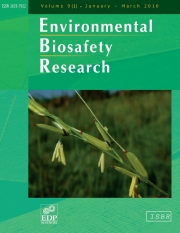Article contents
A method to search for optimal field allocations of transgenic maize in the context of co-existence
Published online by Cambridge University Press: 16 April 2008
Abstract
Spatially isolating genetically modified (GM) maize fields from non-GM maize fields is a robust on-farm measure to keep the adventitious presence of GM material in the harvest of neighboring fields due to cross-fertilizations below the European labeling threshold of 0.9%. However, the implementation of mandatory and rigid isolation perimeters can affect the farmers' freedom of choice to grow GM maize on their fields if neighboring farmers do not concur with their respective cropping intentions and crop plans. To minimize the presence of non-GM maize within isolation perimeters implemented around GM maize fields, a method was developed for optimally allocating GM maize to a particular set of fields. Using a Geographic Information System dataset and Monte Carlo analyses, three scenarios were tested in a maize cultivation area with a low maize share in Flanders (Belgium). It was assumed that some farmers would act in collaboration by sharing the allocation of all their arable land for the cultivation of GM maize. From the large number of possible allocations of GM maize to any field of the shared pool of arable land, the best field combinations were selected. Compared to a random allocation of GM maize, the best field combinations made it possible to reduce spatial co-existence problems, since at least two times less non-GM maize fields and their corresponding farmers occurred within the implemented isolation perimeters. In the selected field sets, the mean field size was always larger than the mean field size of the common pool of arable land. These preliminary data confirm that the optimal allocation of GM maize over the landscape might theoretically be a valuable option to facilitate the implementation of rigid isolation perimeters imposed by law.
Keywords
Information
- Type
- Research Article
- Information
- Copyright
- © ISBR, EDP Sciences, 2008
References
- 8
- Cited by

